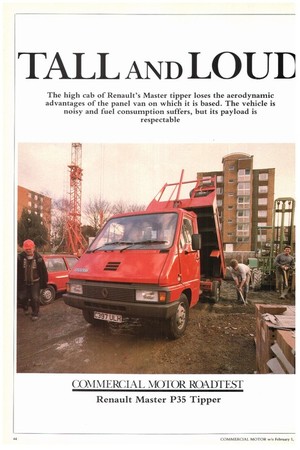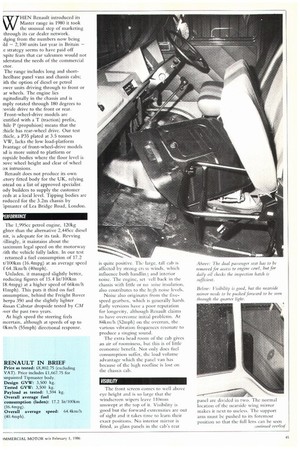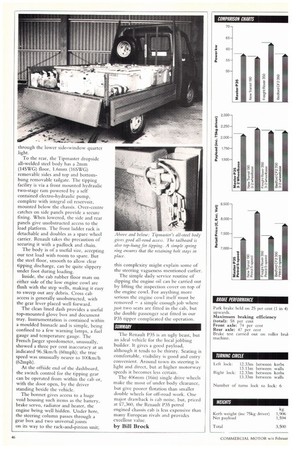TALL AND LOU__
Page 44

Page 45

Page 46

If you've noticed an error in this article please click here to report it so we can fix it.
The high cab of Renault's Master tipper loses the aerodynamic advantages of the panel van on which it is based. The vehicle is noisy and fuel consumption suffers, but its payload is respectable
WHEN Renault introduced its Master range in 1980 it took the unusual step of marketing through its car dealer network. dging from the numbers now being Id — 2,100 units last year in Britain — c strategy seems to have paid off :spite fears that car salesmen would not Iderstand the needs of the commercial ctor.
The range includes long and shortheelbase panel vans and chassis cabs; ith the option of diesel or petrol 3wer units driving through to front or ar wheels. The engine lies ngitudinally in the chassis and is mply rotated through 180 degrees to 7ovide drive to the front or rear. Front-wheel-drive models are
Ientified with a T (traction) prefix, iiik P (propulsion) means that the -:.hide has rear-wheel drive. Our test thick, a P35 plated at 3.5 tonnes VW, lacks the low load-platform ivantage of front-wheel-drive models id is more suited to platform or ropside bodies where the floor level is 3ove wheel height and clear of wheel ox intrusions.
Renault does not produce its own Lctory fitted body for the UK, relying istcad on a list of approved specialist ody builders to supply the customer eeds at a local level. Tipping bodies an.. roduced for the 3.2m chassis by ipmaster of Lea Bridge Road, London.
'ERFORMINCE
The 1,995cc petrol engine, 120kg ghter than the alternative 2,445cc diesel nit, is adequate for its task. Revving rillingly, it maintains about the iaximum legal speed on the motorway rith the vehicle fully laden. In our test returned a fuel consumption of 17.2 t/100km (16.4mpg) at an average speed f 64. lkm/h (40mph).
Unladen, it managed slightly better, roducing figures of 15.4 lit/100km I8.4mpg) at a higher speed of 66km/h Ilmph). This puts it third on fuel onsumption, behind the Freight Rover herpa 350 and the slightly lighter Cabstar dropside tested by CM over the past two years.
At high speed the steering feels incertain, although at speeds of up to Okm/h (55mph) directional response.
is quite positive. Thc large, tall cab is affected by strong ems winds, which influence both handlin,,, and interior noise. The engine, set vell back in the chassis with little or no wise insulation, also contributes to the In j,h noise levels.
Noise also originates from the fivespeed gearbox, which is generally harsh. Early versions have a poor reputation for longevity, although Renault claims to have overcome initial problems. At 84km/h (52mph) on the overrun, the various vibration frequences resonate to produce a singing sound.
The extra head room of the cab gives an air of roominess, but this is of little economic benefit. Not only does fuel consumption suffer, the load volume advantage which the panel van has because of the high roofline is lost on the chassis cab.
The front screen comes to well above eye height and is so large that the windscreen wipers leave 11 Onim unswept at the top of it. Visibility is good hut the forward extremities arc out of sight and it takes time to learn their exact positions. No interior mirror is fitted, as glass panels in the cab's rear
panel are divided in two. The normal location of the nearside wing mirror makes it next to useless. The support arm must be pushed to its foremost position so that the full lens can he seen
through the lower side-window quarter light.
To the rear, the Tipmaster dropside all-welded steel body has a 2mm (14SWG) floor, 1.6mm (16SWG) removable sides and top and bottomhung removable tailgate. The tipping facility is via a front mounted hydraulic two-stage ram powered by a self contained electro-hydraulic pump, complete with integral oil reservoir, mounted below the chassis. Over-centre catches on side panels provide a secure fixing. When lowered, the side and rear panels give unobstructed access to the load platform. The front ladder rack is detachable and doubles as a spare wheel carrier. Renault takes the precaution of securing it with a padlock and chain.
The body is of a useful size, accepting our test load with room to spare. But the steel floor, smooth to allow clear tipping discharge, can be quite slippery under foot during loading.
Inside, the cab rubber floor mats on either side of the low engine cowl are flush with the step wells, making it easy to sweep out any debris. Cross cab access is generally unobstructed, with the gear lever placed well forward.
The clean lined dash provides a useful top-mounted glove box and document tray. Instrumentation is contained within a moulded binnacle and is simple, being confined to a few warning lamps, a fuel gauge and temperature gauge. The French Jaeger speedometer, unusually, showed a three per cent inaccuracy at an indicated 96.5km/h (60mph); the true speed was unusually nearer to 100km/h (62mph).
At the offside end of the dashboard, the switch control for the tipping gear can be operated from within the cab or, with the door open, by the driver standing beside the vehicle.
The bonnet gives access to a huge void housing such items as the battery, brake servo, radiator and heater, the engine being well hidden. Under here, the steering column passes through a gear box and two universal joints on its way to the rack-and-pinion unit; this complexity might explain some of the steering vagueness mentioned earlier.
The simple daily service routine of dipping the engine oil can be carried out by lifting the inspection cover on top of the engine cowl. For anything more serious the engine cowl itself must be removed — a simple enough job where just two seats arc fitted in the cab, but the double passenger seat fitted in our P35 tipper complicated the operation.
SUMMARY
The Renault P35 is an ugly beast, but an ideal vehicle for the local jobbing builder. It gives a good payload, although it tends to be thirsty. Seating is comfortable, visibility is good and entry convenient. Around town its steering is light and direct, but at higher motorway speeds it becomes less certain.
The 406mm (16in) single drive wheels make the most of under body clearance, but give poorer flotation than smaller double wheels for off-road work. One major drawback is cab noise, but, priced at £7,360, the Renault P35 petrol engincd chassis cab is less expensive than many European rivals and provides excellent value.
by Bill Brock




















































